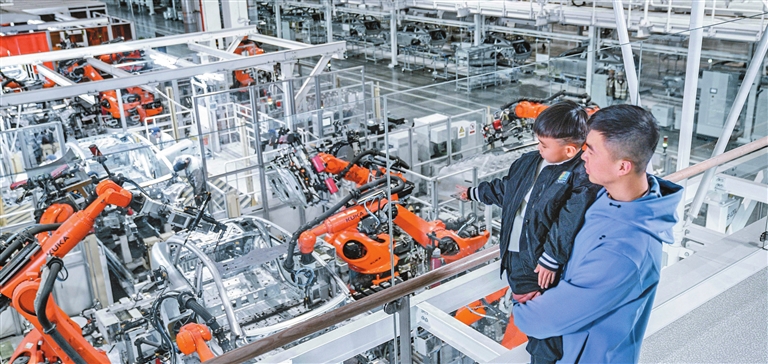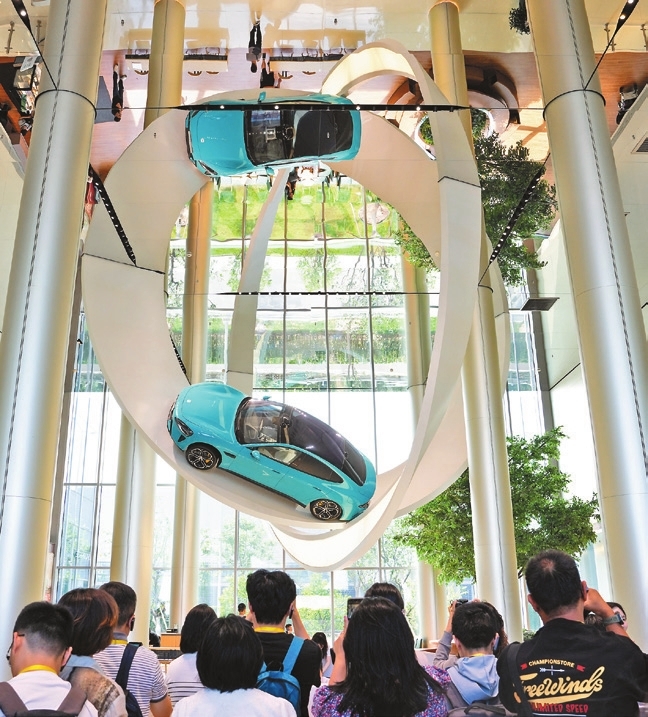




GETTING a pass into Xiaomi’s car plant in suburban Beijing feels like snagging front-row tickets to the world’s hottest concert. “Application accepted!” Wang Shuang crowed, posting a screenshot to social media. “The last time I felt this giddy was when I landed a Taylor Swift ticket.” Welcome to China’s newest travel craze! High-tech factories have joined ancient palaces and world-class museums as the nation’s must-see destinations. China has dominated as the world’s manufacturing powerhouse for 15 straight years. Yet, in just the past two years, the robust rise of smart manufacturing has revolutionized the country’s once dreary, clang-and-hiss assembly lines into a cultural phenomenon or “industrial Disneyland.” Chinese manufacturers aren’t pioneering this factory fascination. France’s Citroen ignited the trend in the 1950s. Boeing and Toyota plants remain the top U.S. and Japan draws. As the country’s industrial prowess ascends from the lower rungs of the global supply chain to a technology-driven frontier, a profound shift has taken hold. An increasing number of Chinese people now celebrate mechanical ingenuity with reverence, as their pride in homegrown sectors flourishes. The registration page of Xiaomi, a headline-grabbing newcomer to the new energy vehicle (NEV) sector last year, was still live ticking: beside the tiny line “20 spots only,” the counter read “4,060 already applied” as a scramble ensued to witness robotic arms assembling electric cars. Wang snagged that coveted ticket only after camping on the official website for days, finger tap-dancing like a twitchy trigger, until the confirmation flashed alive. Tech odyssey Under the scorching sun, Wang stepped into the factory complex as scheduled. The two-hour journey felt like a tech-filled odyssey. She rode a shuttle vehicle that zipped through the six major workshops: stamping, large die casting, body welding, painting, battery assembly, and final assembly. In her experience, factories were enclosed, dusty, and filled with workers in safety helmets. This time, she saw robotic arms working with micron-level precision on the factory floor and AI-driven robots moving freely along planned routes to deliver battery cell components to their destinations. “It takes just 76 seconds to churn out a new car,” Wang exclaimed in amazement. “Quicker than whipping up a latte.” NIO, another domestic EV manufacturer, has opened its “Second Advanced Manufacturing Base” to the public since October 2023. Visitors can also tour the facility, which is filled with robotic arms, from an elevated corridor. In 2024, over 130,000 people visited the site, including about 900 from overseas. The moves to open production lines to the public came as China’s new energy vehicles have topped the global production and sales charts for nine consecutive years. Along with lithium batteries and photovoltaic products, they form China’s “new export trio,” showcasing the technological upgrades of “Made in China.” Freya Zhang, a research analyst at the investment consulting firm Tech Buzz China, told the magazine Wired that China’s NEV factory tour “offers a chance to not only see the production line up close, but also experience the human side of the brand.” Beyond NEVs, emerging tech hubs are becoming pilgrimage sites. In Hangzhou, an innovative magnet in East China, robotics pioneers like Unitree Robotics draw curated tour groups. At the AG600 final-assembly plant in the southern Chinese city of Zhuhai — host city of China’s premier airshow — a steady stream of visitors is filing through the country’s only extensive special-mission aircraft production line that is open to the public. The AG600 line attracts roughly 40,000 visitors a year, with open-day slots almost booked out to a crowd dominated by the young. The domestically developed amphibious aircraft, which has already entered mass production, can swiftly shuttle between water sources and fire sites, making it a powerful tool for fighting forest fires. Industry tourism is also growing at unexpected destinations: waste treatment plants. Shenzhen, an economic hub of China, now welcomes visitors to four such “eco-parks.” One social media user on Xiaohongshu posted about their visit: The true spectacle lies in the industrial-scale choreography of the facility’s central sorting hall, where a colossal hydraulic claw, operating with uncanny precision, plunges into mountains of refuse and sorts recyclables. “It provides a sense of satisfaction akin to that of playing a claw crane game.” New growth China hosts over 40% of the world’s “lighthouse factories,” and more assembly lines have been digitally transformed, creating an ideal foundation for transforming factory floors into cultural canvases. More Chinese cities have made industrial tourism their new engines for growth. In February, Beijing vowed to create five national industrial-tourism demonstration bases by 2027 and become a leading destination by 2029. The city’s tourism blueprint includes opening high-level autonomous driving scenarios, rocket institutes, and low-altitude economy and green energy routes, while inviting research institutes to grant public access to select labs and assembly halls. Local governments are also looking to outfit industrial tourism itself with next-gen stagecraft. Shanghai is set to weave large language models, the metaverse, and blockchain into richer cultural narratives, while Hunan province in central China will deploy AR, VR, AI, 5G, 3D cinema, and holography to build fully immersive worlds. “Industrial tourism is a nexus where secondary and tertiary industries converge,” said Chen Wei, an expert from Tsinghua University. “It can fuel consumer spending, expand domestic demand, and promote industrial science education.” Among the facilities listed as national industrial tourism demonstration bases are Jiangnan Shipyard in Shanghai, the aerospace supercomputing center on the island of Hainan, and the Zhuzhou electric locomotive production line in Hunan, which is a cradle of China’s high-speed trains, according to China’s Ministry of Culture and Tourism. “Fast-tracking industrial tourism is a strategic move in building a modern industrial system, which serves to unlock growth potential for regional economic vitality,” said Chen. (Xinhua) | 
